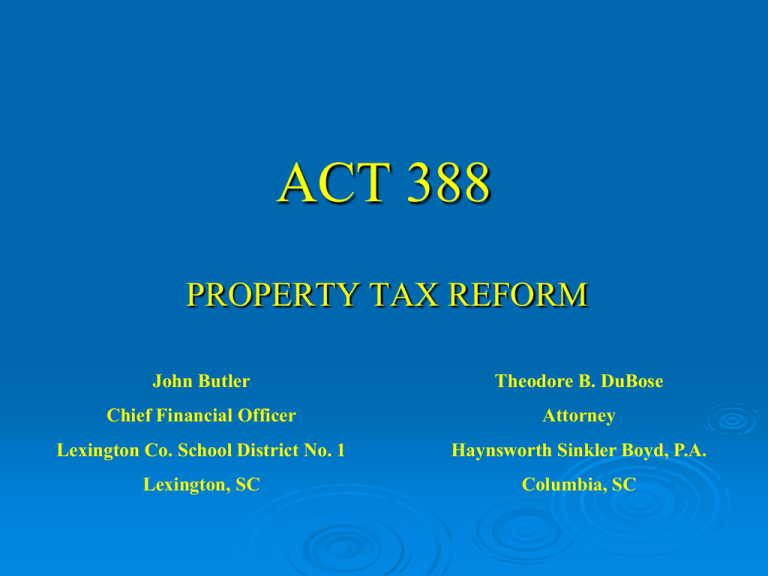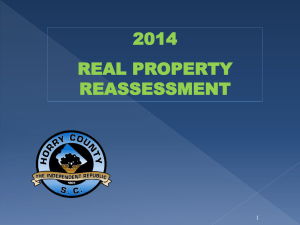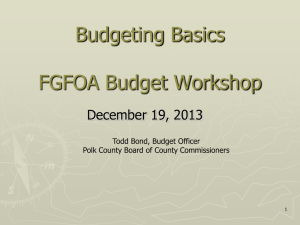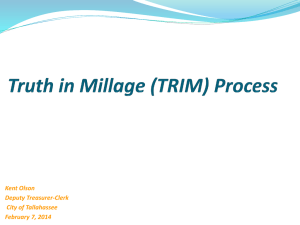ACT 388 - GFOASC.org
advertisement

ACT 388 PROPERTY TAX REFORM John Butler Theodore B. DuBose Chief Financial Officer Attorney Lexington Co. School District No. 1 Haynsworth Sinkler Boyd, P.A. Lexington, SC Columbia, SC At A Glance Passed in 2006 Effective June 1, 2007, increased the state sales tax by 1 cent Reduced the sales tax on unprepared foods (All sales tax on unprepared foods was subsequently eliminated) Provided an exemption of owner-occupied residential property from school operating millage Created the Homestead Exemption Fund Placed a limitation on millage rate increases for all local governing bodies Homestead Exemption Fund (HEF) Proceeds from the additional penny sales tax are credited to a fund separate and distinct for the state general fund The Board of Economic Advisers shall make an annual estimate of the receipts by the HEF by February 15 This estimate must be provided to the legislature and each school district and county Homestead Exemption Fund (HEF) In 2007, additional legislation created three “tiers”: Tier I is the amount received by a district for the first $100,000 of assessment on owner-occupied property Tier II is the amount a district receives for the first $50,000 for taxpayers age 65 or older or those totally and permanently disabled Tier III, for FY 2007-08, consists of an amount equal dollar for dollar to the revenue that would be collected by the district from property tax for school operating purposes imposed by the district on owner-occupied residential property for that fiscal year as if no reimbursed exemptions applied reduced by the total of the district's tier one and tier two reimbursements Distribution of Revenue Beginning with FY 2007-08 school districts were reimbursed for the actual amount that was to be collected from school operating millage imposed on owner-occupied residential property Beginning with FY 2008-09 the aggregate reimbursements are increased annually by an inflation factor equal to the percentage increase in the CPI, SE Region plus the percentage increase in the population of the State as published by the Office of Research and Statistics multiplied by the prior year’s total reimbursements An additional add-on weighting for poverty of .20 was added to provide additional revenues for students in K-12 who qualify for Medicaid or are eligible for free and/or reduced lunches Distribution of Revenue (Continued) Beginning with FY 2008-09 , a school district receives reimbursement for the amount received in prior year plus a proportionate share of the increase above based on of district’s WPU’s as a percentage of statewide WPU’s Any county that did not raise a minimum of $2.5 million from school operating millage must receive and additional reimbursement from the HEF to bring the reimbursements to districts in that county to at leas $2.5 million Multi-district counties qualifying for the additional reimbursement would split the funds based on 135 Day ADM of the district divided by the total ADM of all students of the districts in the county Any funds remaining after all of the above obligations have been met must be distributed to counties for a credit against county operations on owner occupied property taxes Millage Limitation A local governing body may increase millage for general operating purposes above the rate for the previous year only to the extent of the increase in the average CPI for the most recent 12 month period, plus the percentage increase in the previous year increase in the population of the entity Negative population growth was later amended to be zero for purposes of this computation The millage rate limitation may be suspended and the millage rate may be increased upon a 2/3 vote or the local governing body, but only for 5 purposes stated in Act 388 The restriction does not affect millage for levied for bonded indebtedness or used to maintain a reserve account Five Authorized Purposes for Suspending the Millage Limitation 1 2 3 The deficiency of the preceding year; Any catastrophic event outside the control of the governing body such as a natural disaster, severe weather event, act of God, or act of terrorism, fire, war, or riot; Compliance with a court order or decree; Five Purposes for Suspending the Millage Limitation (cont.) 4 5 Taxpayer closure due to circumstances outside the control of the governing body that decreases by ten percent or more the amount of revenue payable to the taxing jurisdiction in the preceding year; or Compliance with a regulation promulgated or statue enacted by the federal or state government after the ratification date of this section for which an appropriation or a method of obtaining an appropriation is not provided by the federal or state government. School Districts’ Perspective Growth Act 388 adversely affects fast growing districts. Act 388 helps slow growing, no growth or declining districts or districts that receive the $2.5 million. Growing Districts $45,000,000.00 $43,000,000.00 $41,000,000.00 $39,000,000.00 $37,000,000.00 $35,000,000.00 $33,000,000.00 $31,000,000.00 $29,000,000.00 $27,000,000.00 $25,000,000.00 Act 388 Funds Res. Tax Amount 2007-08 2008-09 2009-10 2010-11 Proj. Declining Districts $40,000,000 $38,000,000 $36,000,000 $34,000,000 $32,000,000 $30,000,000 $28,000,000 $26,000,000 $24,000,000 $22,000,000 $20,000,000 Act 388 Funds Res. Tax Amount 2007-08 2008-09 2009-10 $2.5 Million Districts $3,000,000 $2,500,000 $2,000,000 $1,500,000 Act 388 Funds $1,000,000 Res. Tax Amount $500,000 $0 2007-08 2008-09 2009-10 Effect on Per Pupil Revenue Growing Enrollment Districts Year WPUs Allocation Per WPU 2008 10,000 $ 20,000,000 $ 2,000 2009 11,000 $ 20,500,000 $ 1,864 2010 12,000 $ 21,000,000 $ 1,750 2011 13,000 $ 21,500,000 $ 1,654 2012 14,000 $ 22,000,000 $ 1,571 2013 15,000 $ 22,500,000 $ 1,500 Effect on Per Pupil Revenue Declining Enrollment Districts Year WPUs Allocation Per Pupil 2008 10,000 $ 20,000,000 $ 2,000 2009 9,500 $ 20,300,000 $ 2,137 2010 9,000 $ 20,600,000 $ 2,289 2011 8,500 $ 20,900,000 $ 2,459 2012 8,000 $ 21,200,000 $ 2,650 2013 7,500 $ 21,500,000 $ 2,867 State Funds Growing districts receive less state money since their Education Finance Act (EFA) amount is based on their owner-occupied assessments and not the amount they receive from Act 388. Declining districts receive more state money since their EFA amount is based on their owner-occupied assessments and not the amount they receive from Act 388. If there is no change in legislation this year this will correct itself for 2010-11, but there was legislation filed last year that would leave this inequity in place and probably will be introduced again this year. Millage Districts are restricted to how much millage they can increase and a mill is worth much less than it was prior to Act 388. The more owner-occupied property a district has, the greater the decline in a value of a mill since owneroccupied assessments are not included in the value now. This also means that any new mills added will be entirely assessed against business and other non owner-occupied property. Property Reclassification 2007-08 was the base year where DOR used the owneroccupied assessments and each district’s millage rate to determine the dollar for dollar reimbursement to districts. Some taxpayers that had 6% property in 2007-08, which is still taxed for school operations, reclassified it to 4% property after the base year in order to obtain the 100% exemption from school operating taxes. Therefore, no tax is now collected on it and it is excluded in the amount the state uses to reimburse districts. Re-assessment The value of property may not be increased by reassessment more than 15%, except in the case of an “assessable transfer of interest.” Legislation debated in 2010 but not passed would have deleted assessable transfer of interest exception. According to a report from the state’s Chief Economist given to Government Finance Officers in December of 2008, this will have a greater adverse effect on school districts than Act 388 in the long term. This was enacted as a result of a constitutional amendment through a state-wide vote by citizens. Bright spot: For the purpose of calculating debt limit, assessed value shall not be lower than 2006 assessed value. IMPACT OF 15% CAP ON REASSESSMENT: LOST REVENUE, LOST DEBT LIMIT Year Assuming Three Percent 15% Cap on 25% Growth Annual Growth Reassessment Over 5 Years 2006 $150,000,000 $150,000,000 $150,000,000 Amount of Value Not Taxed 2011 173,891,111 172,500,000 187,500,000 8.70% 2016 201,587,457 198,375,000 234,375,000 18.15% 2021 233,695,112 228,131,250 292,968,750 28.42% Assuming total millage rate of 253 mills, annual lost revenue in 2021 would exceed $16,200,000. By 2021, lost debt limit capacity would be approximately $5,200,000. IMPACT OF 15% CAP ON REASSESSMENT: UNEQUAL TAX BURDEN House Built in the Year 2005 House Built in the Year 2011 House Built in the Year 2016 House Built in the Year 2021 Year 2006 2007 2008 2009 2010 2011 2012 2013 2014 2015 2016 2017 2018 2019 2020 2021 $200,000 200,000 200,000 200,000 200,000 230,000 230,000 230,000 230,000 230,000 264,500 264,500 264,500 264,500 264,500 304,175 $250,000 250,000 250,000 250,000 250,000 287,500 287,500 287,500 287,500 287,500 330,625 $312,500 312,500 312,500 312,500 312,500 359,375 $390,625 Assuming a total millage rate of 253 mills, by 2021, tax on identical properties would vary by as much as $875. Avoiding The Millage Cap Using Your Debt Limit for Capital Expenditures Simple Counties and municipalities may issue general obligation debt for any corporate purpose. Many counties and cities use general fund millage to fund capital expenditures. Consider using general obligation bond funds, instead of general funds, to fund capital expenditures. Bonds can be issued for short period, keeping interest costs at a minimum. Owing to petition rules, timing is critical. Not as Simple Act 388 makes it difficult in some cases to engage in lease-purchase financings for equipment and other capital items. Consider using proceeds of general obligation bonds to make payments on lease-purchase agreements. Again, timing is critical. Additional wrinkle for school districts— installment payments. SEVEN YEAR LEASING PLAN Separate lease agreements for each FY All payments due in a FY on all leases repaid through short term g.o. bond. FY 2010-2011 Fire Engine Vehicles Truck Rescue 1 2 1 1 250,000 200,000 40,000 80,000 Total for Year FY 2011-2012 Fire Engine Large Ambulance Sanitation 1 2 1 250,000 200,000 140,000 Total for Year FY 2012-2013 Public Works Vehicle Pickup Truck Ambulance Total for Year 1 2 1 250,000 40,000 140,000 $ 250,000 400,000 40,000 80,000 $ 770,000 $ 250,000 400,000 140,000 $ 790,000 $ 250,000 80,000 140,000 $ 470,000 FY 2013-2014 No vehicles for the year FY 2014-2015 Public Works Equipment Motor Pool 2 10 250,000 28,000 Total for Year FY2015-2016 Fire Engine Rescue Pickup Sheriff's Dept Vehicles 1 2 2 5 $ 500,000 280,000 $ 780,000 250,000 100,000 40,000 28,000 Total for Year 250,000 200,000 80,000 140,000 $ 670,000 $ 500,000 280,000 Total for Year $ 780,000 GRAND TOTAL $ 4,260,000 FY 2016-2017 Sanitation Motor Pool 4 10 125,000 28,000 SEVEN YEAR LEASING PLAN Separate lease agreements for each FY All payments due in a FY on all leases repaid through short term g.o. bond. PRO FORMA SCHEDULE OF LEASE PURCHASE AGREEMENTS. Payments on Payments on Payments on Payments on Payments on Payments on Payments on Total Fiscal $770,000 $790,000 $470,000 $0 $780,000 $670,000 $780,000 Annual Lease Year 2011 Lease 2012 Lease 2013 Lease 2014 Lease 2015 Lease 2016 Lease 2017 Lease Payment 2011 2012 2013 2014 2015 2016 2017 2018 2019 2020 2021 $167,677 167,677 167,677 167,677 167,677 $172,033 172,033 172,033 172,033 172,033 $102,385 102,385 102,385 102,385 102,385 $169,855 169,855 169,855 169,855 169,855 $145,901 145,901 145,901 145,901 145,901 $169,855 169,855 169,855 169,855 169,855 $167,677 339,710 442,095 442,095 611,950 590,174 587,996 485,611 485,611 315,756 169,855 SEVEN YEAR LEASING PLAN Separate lease agreements for each FY All payments due in a FY on all leases repaid through short term g.o. bond. SCHEDULE AND ESTIMATED MILLAGE IMPACT OF BOND ISSUES Fiscal Year 2011 2012 2013 2014 2015 2016 2017 2018 2019 2020 2021 Total Lease Payment Due $167,677 339,710 442,095 442,095 611,950 590,174 587,996 485,611 485,611 315,756 169,855 3.50% Bond Three Issue Months Amount Interest Total Debt Service $176,677 348,710 451,095 451,095 620,950 599,174 596,996 494,611 494,611 324,756 178,855 $178,223 351,761 455,042 455,042 626,383 604,417 602,220 498,939 498,939 327,598 180,420 $1,546 3,051 3,947 3,947 5,433 5,243 5,224 4,328 4,328 2,842 1,565 Mill Value $100,000 100,500 101,003 101,508 102,015 102,525 103,038 103,553 104,071 104,591 105,114 Millage Required 1.78 3.50 4.51 4.48 6.14 5.90 5.84 4.82 4.79 3.13 1.72 Bonds will be issued in December of each year and paid off in March 1 of the following year.











